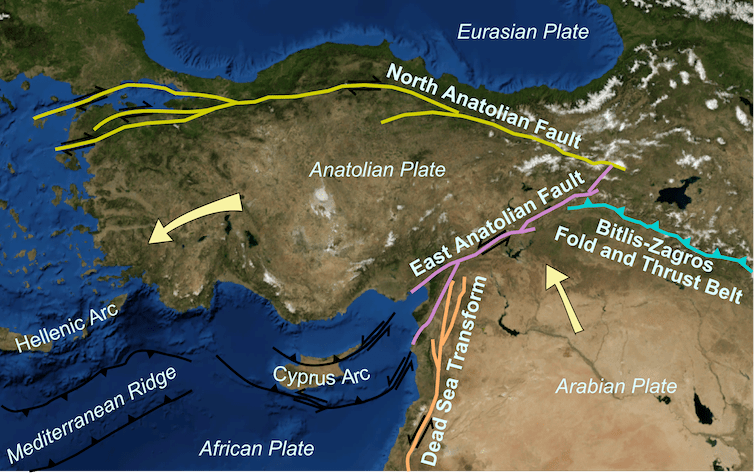[ad_1]
Seismologist Explains the Recent Earthquake in Turkey-Syria: What We Know and What to Expect
An extremely large earthquake has occurred in south-eastern Turkey, near the border with Syria. Data from seismometers measuring ground shaking caused by earthquake waves suggest that this event had a magnitude of 7.8 out of 10 on the moment magnitude scale. Seismic waves have been detected by sensors around the world (you can watch them waves through Europe) including places as far away as the UK.
This was a really big deal.
The shaking caused by energy traveling outward from the source or epicenter is already wreaking havoc on those living nearby. Many buildings have collapsed, at least 2,000 people are believed to have died in both countries, and there have been reports of damage to gas lines leading to fires.
Why this happened here
This area of Turkey is prone to earthquakes as it lies at the intersection of three of the tectonic plates that make up the Earth’s crust: the Anatolian, Arabian and African plates. Arabia is moving northward into Europe, causing the Anatolian Plate (on which Turkey sits) to be shifted westward.
Map of tectonic plate movements around Turkey
The movement of the tectonic plates builds pressure on fault zones at their boundaries. It is the sudden release of this pressure that causes earthquakes and ground shaking.
This latest earthquake likely occurred at one of the largest faults that mark the boundaries between the Anatolian and Arabian plates: either the East Anatolian Fault or the Dead Sea Transform Fault. These are both “strike slip errors,” meaning they pick up some movement from plates moving past one another.
“Significantly larger” than previous earthquakes
While there are many earthquakes in this area each year caused by the continued movement of the tectonic plates, today’s earthquake is particularly large and devastating because so much energy was released. The United States Geological Survey (USGS) reports that only three earthquakes greater than magnitude 6 have occurred within a 150-mile radius of this location since 1970. At a magnitude of 7.8, the Feb. 6 event is significantly larger than earthquakes the area has experienced before and triggered more than twice the energy of the region’s largest earthquake on record (size 7.4).
Modern seismologists use the moment magnitude scale, which represents the amount of energy released by an earthquake (the Richter scale is outdated, but is sometimes incorrectly quoted in the news). This scale is not linear: each step up corresponds to 32 times more energy released. That means a magnitude 7.8 earthquake actually releases about 6,000 times more energy than the more moderate magnitude 5 earthquakes that can typically occur in the region.
We tend to think of earthquake energy as coming from a single location or epicenter, but they are actually caused by movement along a fault area. The stronger the earthquake, the larger the fault plane that will have shifted. For something as large as this magnitude 7.8, there should have been movement over an area about 120 miles long and 15 miles wide. This means that the shaking can be felt over a very large area.
It is estimated that 610,000 people in the area felt severe to violent tremors (enough to cause significant property damage) up to a distance of approximately 80 km northeast along the tectonic plate boundary. Slight tremors could be felt as far away as the Turkish capital of Istanbul (approx. 815 km away), as well as in Baghdad in Iraq (800 km) and Cairo in Egypt (950 km).
What about aftershocks?
After large earthquakes, there will be many smaller earthquakes, known as aftershocks, as the crust adjusts to the changes in loading. These can last days to years after the initial event. In the first 12 hours after the first quake in south-eastern Turkey, there were already three other earthquakes with a magnitude of more than 6.0. The first was a 6.7 that occurred just 11 minutes after the initial shock and there were hundreds of lower magnitude aftershocks.
Later in the morning, another very large magnitude 7.5 occurred further north on a different but adjacent fault system: the Sürgü Fault. Technically, this earthquake was strong enough to be considered an earthquake in its own right, although it was likely triggered by the first earthquake and will trigger its own series of aftershocks.
While aftershocks are usually significantly smaller than the main tremor, they can be equally devastating, further damaging infrastructure damaged by the initial earthquake and hampering rescue efforts.
As people in this region continue to feel the aftermath of this major earthquake, we can only hope that international aid will reach Turkey and Syria as soon as possible to assist with ongoing rescue efforts amid the ongoing aftershocks
This article was republished by The Conversation under a Creative Commons license. Read the original article.
The conversation
Jenny Jenkins does not work for, advise, own any shares in, or receive funding from any company or organization that would benefit from this article, and has disclosed no relevant affiliations other than her academic appointment.
[ad_2]
Don’t miss interesting posts on Famousbio
